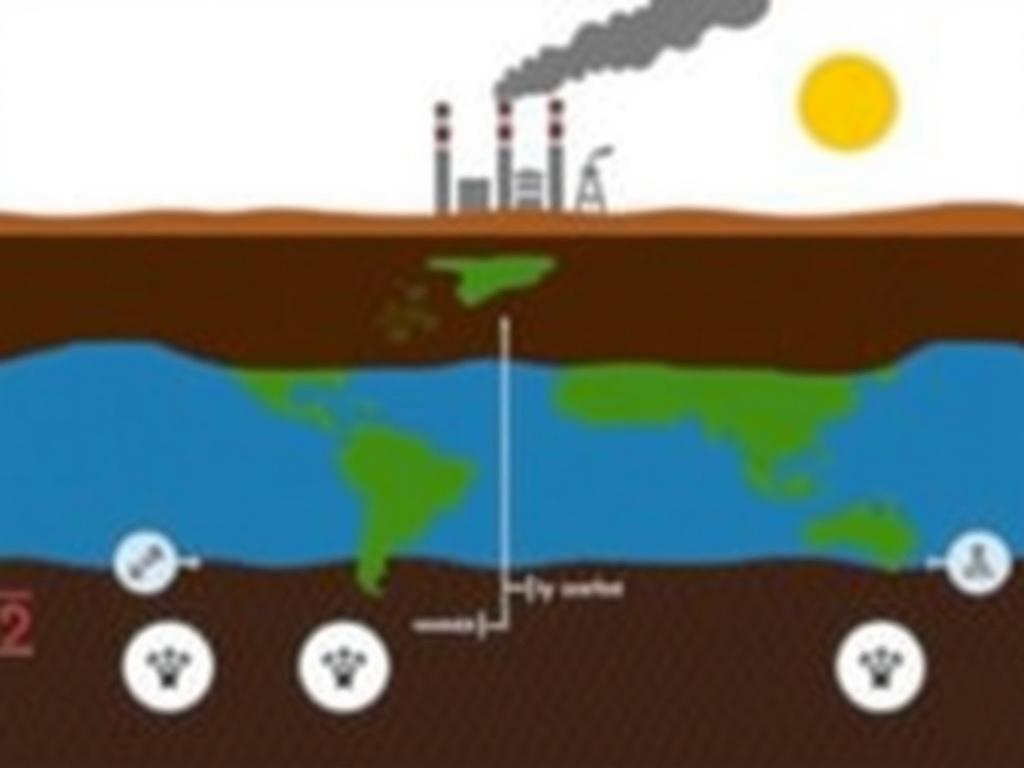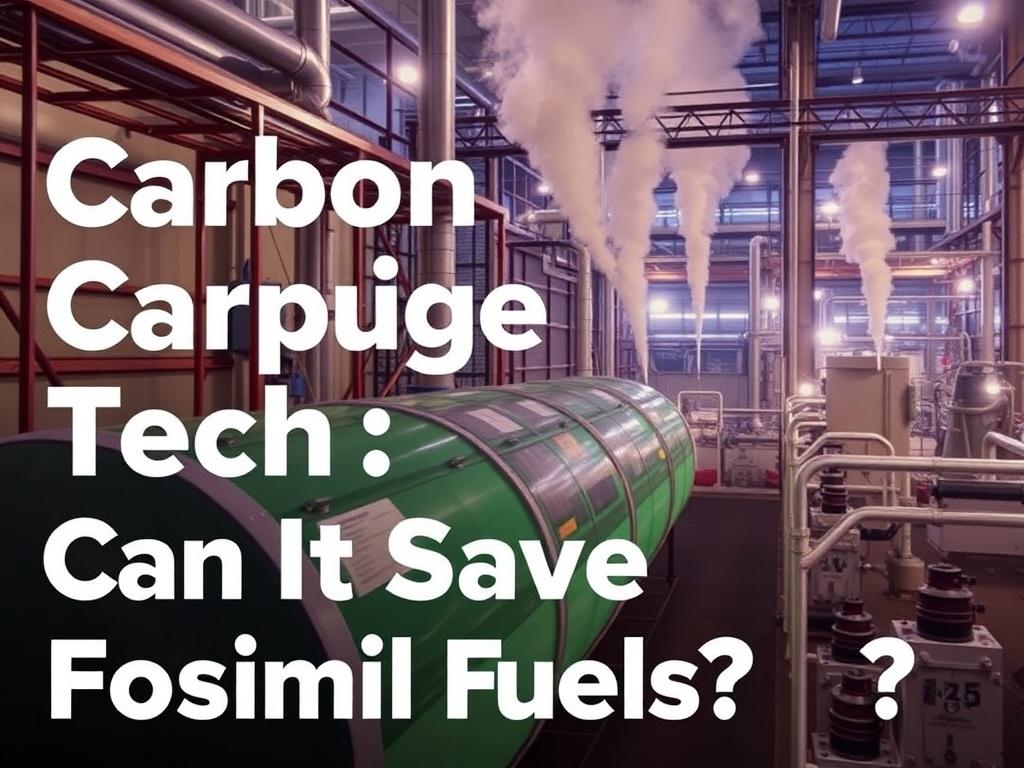- What is Carbon Capture Technology?
- Why Use Carbon Capture Tech?
- How Effective is Carbon Capture Tech?
- Can Carbon Capture Tech Really Save Fossil Fuels?
- Economic and Policy Considerations
- Innovations and Future Outlook in Carbon Capture
- Global Impact and Key Players
- Challenges Facing Carbon Capture Tech
- Can Carbon Capture Tech Align with a Sustainable Future?
- What the Experts Say
- Summary Table: Carbon Capture Tech’s Role in Fossil Fuels
- Conclusion
In a world desperately seeking solutions to climate change, carbon capture technology has emerged as a beacon of hope—or a controversial stopgap, depending on whom you ask. As governments, industries, and scientists tussle with finding sustainable ways to reduce greenhouse gas emissions, carbon capture and storage (CCS) steps into the spotlight as a potential game-changer. But the question remains: can carbon capture tech really save fossil fuels, or is it merely prolonging a hazardous dependence on dirty energy? In this article, we’ll dive into the science, benefits, limitations, and future prospects of carbon capture tech, exploring its role in the evolving energy landscape.
What is Carbon Capture Technology?
At its core, carbon capture technology refers to the processes designed to capture carbon dioxide (CO2) emissions from sources like power plants and industrial facilities before they enter the atmosphere. The captured CO2 is then transported and stored underground or utilized in various industrial applications. This technique aims to reduce the carbon footprint of fossil fuel-based operations, which remain a significant contributor to global greenhouse gas emissions.
Carbon capture technology includes several methods, each with its own advantages and challenges:
- Pre-combustion capture: CO2 is removed from fossil fuels before combustion, usually via gasification.
- Post-combustion capture: CO2 is extracted from flue gases after the fuel has been burned.
- Oxy-fuel combustion: Fossil fuels are burned in pure oxygen, producing a flue gas that is mostly water vapor and CO2, making capture easier.
Understanding these methods is key to assessing the feasibility of using carbon capture tech to make fossil fuel use more environmentally friendly.
Why Use Carbon Capture Tech?
The primary motivation behind developing and deploying carbon capture technology is to mitigate climate change by reducing CO2 emissions. Fossil fuels like coal, oil, and natural gas currently provide about 80% of the world’s energy, but their combustion releases enormous amounts of CO2. Until alternatives can completely replace fossil fuels, carbon capture offers a way to significantly lower these emissions.
Additionally, carbon capture tech has some unique roles:
- Decarbonizing heavy industries: Cement, steel, and chemical manufacturing are tough to electrify. Carbon capture can help reduce emissions in these sectors.
- Supporting “blue” hydrogen production: Hydrogen made from natural gas coupled with carbon capture produces lower emissions.
- Enhancing oil recovery: Captured CO2 can be injected into fossil fuel reservoirs to extract more oil, a practice known as enhanced oil recovery (EOR).
This last point is where carbon capture tech’s role in “saving fossil fuels” becomes contentious, since it can actually encourage continued oil and gas extraction.
How Effective is Carbon Capture Tech?
Effectiveness depends on multiple factors including the capture rate, energy consumption of the capture process, transportation, and storage integrity.
Modern carbon capture systems can capture around 85% to 95% of CO2 emissions from a power plant’s flue gas. However, implementing these systems requires significant energy, known as the “energy penalty,” which can reduce overall plant efficiency by 20-30%. This means more fuel must be burned to produce the same net energy output, somewhat offsetting the benefits.
In terms of transportation and storage, captured CO2 is often compressed and transported via pipelines to underground geological formations such as:’)
| Storage Type | Description | Capacity |
|---|---|---|
| Depleted Oil and Gas Reservoirs | Use of former fossil fuel reservoirs for CO2 injection | High, due to understanding of site geology |
| Deep Saline Aquifers | Porous rock formations filled with salty water | Very large, potential for billions of tons |
| Unmineable Coal Seams | Inject CO2 to displace methane, can enhance coalbed methane recovery | Moderate |
Storage sites undergo rigorous testing to ensure CO2 remains securely trapped for thousands of years, minimizing leakage risks. Still, long-term monitoring is required, and some uncertainties remain.
Can Carbon Capture Tech Really Save Fossil Fuels?
This question touches on both environmental and economic debates. Carbon capture technology can extend the lifespan of existing fossil fuel infrastructure by mitigating its climate impact, but does this translate to a sustainable future?
On the one hand, carbon capture enables current fossil fuel plants to continue operating with lower emissions, buying time for renewable energy technologies and grid upgrades to scale up. It can also make “blue hydrogen” an affordable alternative to “green hydrogen” produced from electrolysis.
On the other hand, critics argue that carbon capture encourages reliance on fossil fuels, delaying a much-needed transition to renewables. For example, reinjecting captured CO2 for enhanced oil recovery increases oil production, creating more emissions downstream. This creates a paradox where carbon capture tech might save fossil fuels by making them appear cleaner, but ultimately prolong carbon dependency.
Economic and Policy Considerations
The adoption of carbon capture technology also hinges on economics and policy frameworks. Building and operating CCS facilities is capital intensive, often with high upfront and operational costs.
The governments around the world have started to incentivize CCS through subsidies, tax credits, and carbon pricing policies. For instance, the United States’ 45Q tax credit offers $50 per ton of CO2 stored and $35 per ton for utilization projects, encouraging investments.
This table highlights some of the benefits and drawbacks of carbon capture tech related to fossil fuels:
| Benefits | Drawbacks |
|---|---|
| Reduces CO2 emissions significantly from existing fossil fuel plants | High operational costs and energy penalty reduce efficiency |
| Can decarbonize difficult-to-electrify industries | Might extend fossil fuel dependence, delaying renewable adoption |
| Supports development of blue hydrogen as lower-carbon fuel | Enhanced oil recovery increases fossil fuel extraction and emissions |
| Provides a bridge solution during energy transition | Long-term storage and leakage concerns remain |
Innovations and Future Outlook in Carbon Capture
Ongoing research aims to improve carbon capture tech’s efficiency and reduce costs, making it more palatable for widespread adoption. Innovations include:
- Advanced solvents and adsorbents: Developing materials that absorb CO2 more effectively and with less energy input.
- Direct air capture (DAC): Technologies pulling CO2 directly from ambient air rather than just point sources, potentially offsetting historic emissions.
- Integration with renewable energy: Using clean electricity to drive carbon capture processes, minimizing energy penalty.
- CO2 utilization: Transforming captured carbon into products like building materials, fuels, or plastics.
These innovations could redefine the relationship between carbon capture tech and fossil fuels. Instead of solely focusing on saving fossil fuels, future applications might help create a circular carbon economy where CO2 becomes a valuable resource rather than waste.
Global Impact and Key Players
Carbon capture tech is developing unevenly worldwide, with some countries leading the charge and others lagging behind.
Here’s a quick look at major regions and their CCS efforts:
| Region | CCS Status | Notable Projects |
|---|---|---|
| United States | Advanced, multiple commercial-scale projects | Petra Nova (Texas), Illinois Industrial CCS Project |
| Europe | Rapid expansion, strong policy support | Northern Lights (Norway), Drax Power Station (UK) |
| China | Emerging market, growing investments | GreenGen CCS project, Sinopec Qilu |
| Australia | Early stage, focused on research | Gorgon CO2 Injection Project |
The success and sustainability of carbon capture tech will depend on global cooperation, regulatory frameworks, and public acceptance.
Challenges Facing Carbon Capture Tech
Despite its promise, carbon capture tech confronts several significant hurdles. First, its deployment is expensive, and the energy penalty makes the process less efficient than fossil fuel plants without CCS.
Secondly, the technology requires significant infrastructure for CO2 transport and storage, which isn’t widely developed. Building pipelines and securing multiple storage sites carries risks and social resistance.
Third, there’s a notable ethical debate: should we invest in capturing carbon from fossil fuels, or rather shift funds toward renewable energy and energy efficiency?
Lastly, the long-term safety of CO2 storage demands continuous monitoring and risk mitigation to prevent leaks, which could undermine climate benefits.
Can Carbon Capture Tech Align with a Sustainable Future?
Despite the challenges, carbon capture tech may have a vital role in managing the climate crisis—if integrated thoughtfully within broader energy transitions. It may not «save» fossil fuels in the traditional sense but can help reduce their harmful impact.
For instance, pairing carbon capture with renewable energy, investing in green hydrogen, and developing industries with lower emissions creates a balanced path forward. Policymakers must ensure CCS projects don’t become fossil fuel lifelines but instead part of a decarbonized energy ecosystem.
What the Experts Say
- Many climate experts view CCS as a necessary “bridge technology” to limit global warming to safe levels.
- Some emphasize maximizing investments in renewables while using CCS strategically for hard-to-abate emissions.
- Others warn that overreliance on carbon capture risks locking in fossil fuel dominance and missing critical climate targets.
The ongoing debate not only shapes public opinion but also funding and policy directions for CCS development worldwide.
Summary Table: Carbon Capture Tech’s Role in Fossil Fuels
| Aspect | Carbon Capture Technology Impact |
|---|---|
| Environmental | Reduces CO2 emissions from fossil fuels; potential leakage concerns; mitigates but doesn’t eliminate emissions |
| Economic | High upfront and operational costs; incentives needed; can extend life of fossil fuel assets |
| Technological | Effective but energy-intensive; innovations ongoing to improve efficiency |
| Policy | Dependent on subsidies, carbon pricing, and regulations; global variations in adoption |
| Social | Public acceptance mixed; risks of fossil fuel lock-in vs climate benefits |
Conclusion

Carbon capture technology stands at a critical crossroads. It offers a promising way to reduce carbon emissions from fossil fuels, enabling industries and power plants to lower their climate impact in the near term. Yet, its success hinges on overcoming technical, economic, and ethical challenges. While carbon capture may help “save” fossil fuels by making their use cleaner, it should not be viewed as a license to delay the urgent shift to renewable energy. Instead, CCS must be integrated as part of a comprehensive strategy to transition toward a sustainable future—one that balances emission reductions with energy security and economic needs. Ultimately, carbon capture tech could either serve as a vital tool in the global fight against climate change or a costly diversion from the fundamental transformation the energy system demands. The path forward requires thoughtful policies, continued innovation, and a commitment to a low-carbon future beyond fossil fuels.
Как вам статья?







